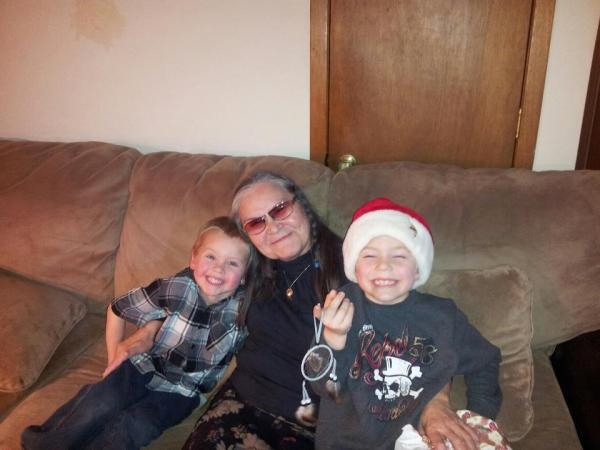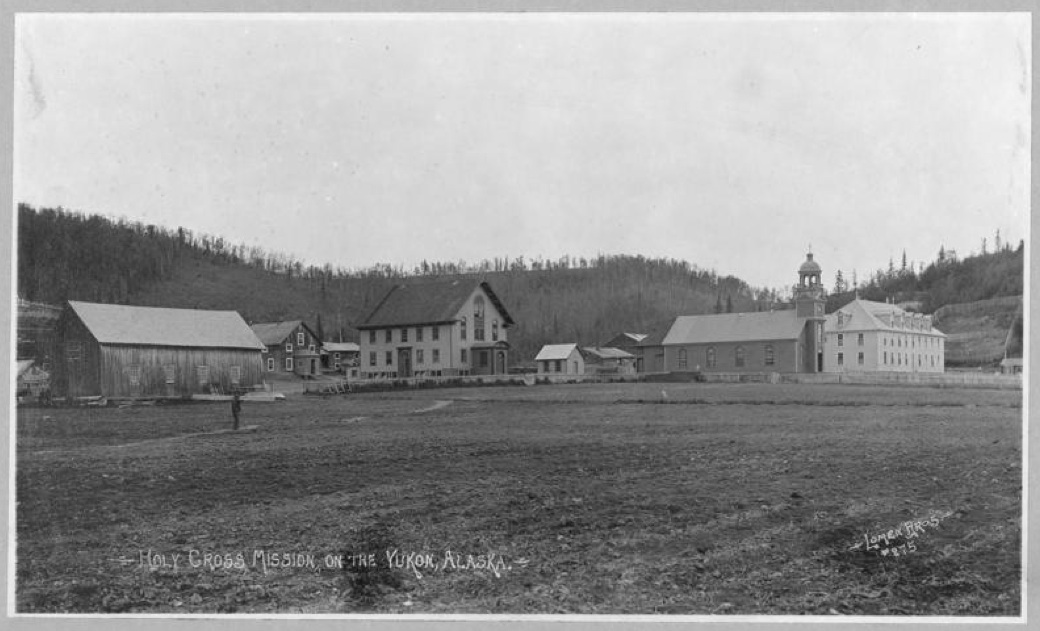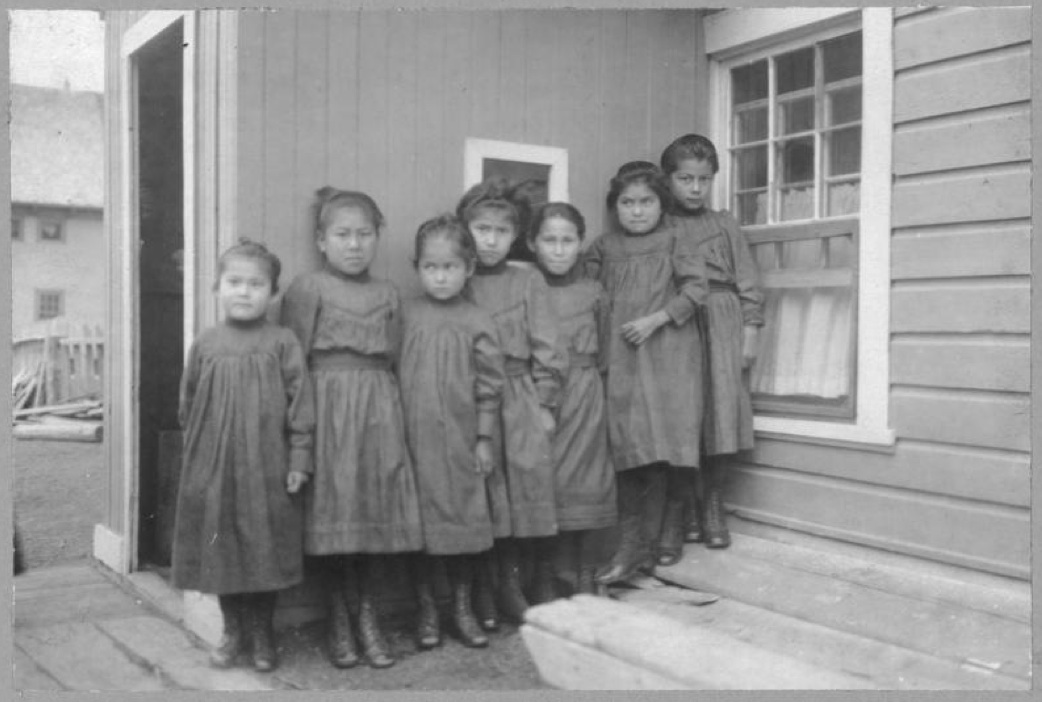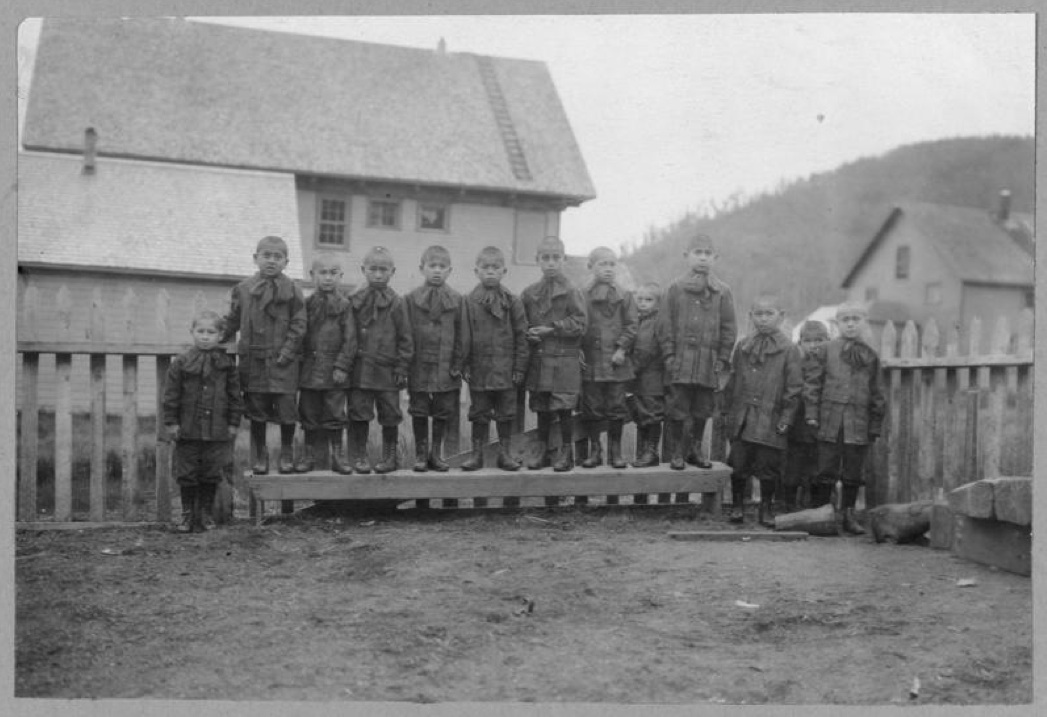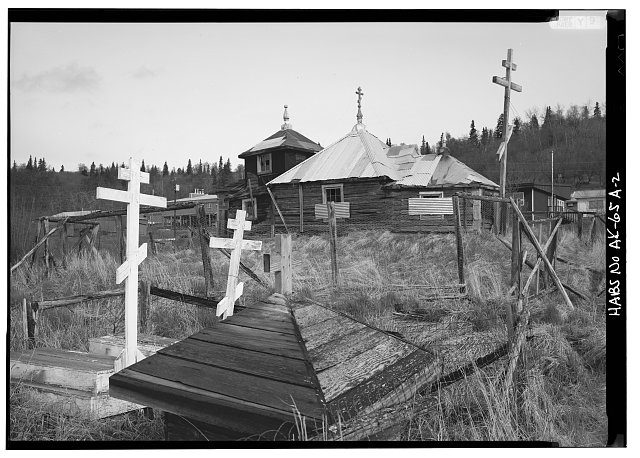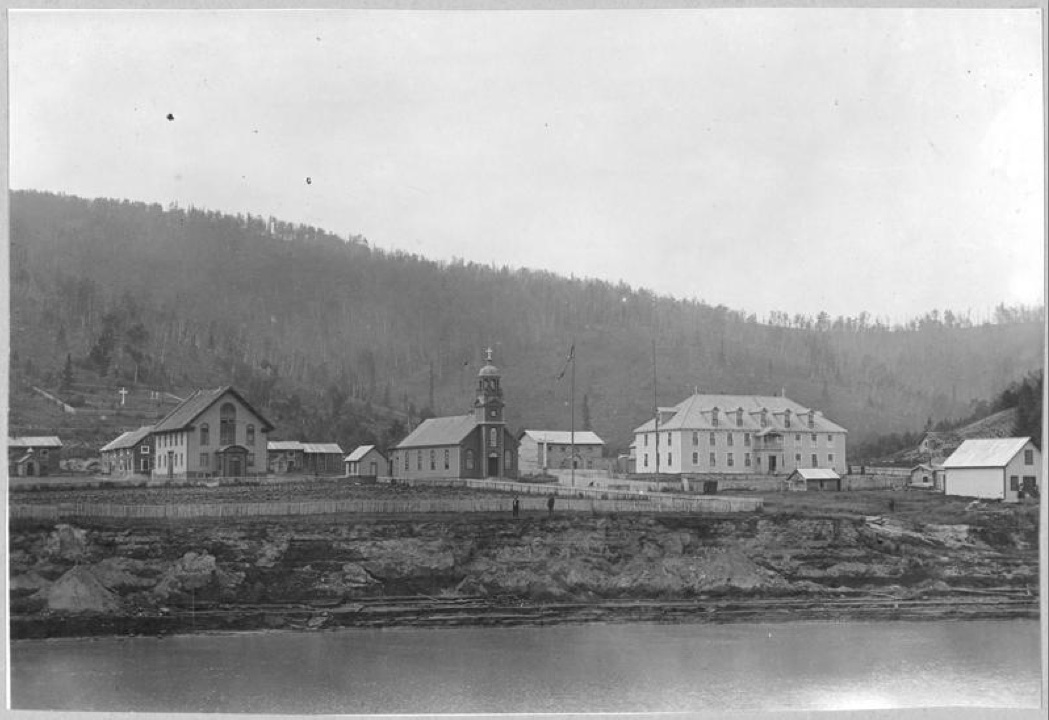The Last Orphans of Holy Cross
By Mary Annette Pember
The memories are coming back to her now in bits and pieces. Sometimes they emerge slowly and sometimes they engulf her bringing a terrible pain she describes as a tsunami wave of hurt. When this happens she raises her arms up in the air. “I say, dear God in heaven, please help me, and I pray. Prayers keep you in a line of goodness,” said Kim Oseira, Alaskan Native and survivor of the Holy Cross Mission Orphanage in Holy Cross, Alaska. The boarding school, located along the Yukon River, over 400 miles from Fairbanks, was officially called an orphanage in church records. Holy Cross Mission was founded in 1880 near the village of Holy Cross, a community of Athabascan and Yupik Eskimos, according to the Holy Cross tribal website. The early mission included a day school, boarding school and church. Today, only a church remains, the Holy Family Catholic Church served by Catholic diocese of Fairbanks. Oseira, 73, has come forward to tell her story because, she says, “It is time.” Over several hours and multiple interviews she takes us through her childhood years at the Jesuit orphanage, sharing memories that she once thought were “completely blotted out.” Her history, she says, is the same as so many other Native children who were taken from their families and raised in religious mission boarding schools in Canada and Alaska.
“This [story] is for those who can’t speak up, for those who’ve died or gone off the edge into mental illness or addiction,” she said. She is sharing the account in hopes that it will help serve as a memorial for those who have been silenced and guide them towards some form of catharsis and healing. And of course she is coming forward for Della Mae, always for Della Mae. There are few adults in Oseira’s earliest memories. She seemed to be alone even at age five in Nome, Alaska, where she was the primary care giver for her sister, Della Mae, two years younger. “I was responsible for feeding her, changing her diapers, teaching her how to go potty, everything,” she recalls. Later she learned that her birth parents, non-Native father and Alaska Native mother, were chronic alcoholics. Oseira was five years old in 1945 when her mother was sent to a TB sanatorium and suddenly everything changed. Her memories are returning in a series of vignettes such as the following; she is on a plane and holding tightly onto Della Mae. There is a man wearing a uniform in the plane with them but he ignores them, speaking only to the pilot. “All I remember is desperately holding onto Della Mae. For some reason we were each wearing new dresses and carrying dolls. We’d never had dolls before. Della Mae wore blue and I wore pink,” she recalls. Frightened, she looks down at the ground as the plane begins to descend toward a huge, stark white cross. The vision of the cross is a mark, an ominous symbol that fills her with dread. That feeling of fear dominated her childhood during the next 12 years that she and Della Mae lived at Holy Cross Orphanage. After the plane lands, the man in the uniform takes the girls to a dirt road and points. “He told us to walk until we came to a building, “ she said. The man gets back on the plane and she and Della Mae begin to walk the two miles to Holy Cross mission.
In Oseira’s memory, the doll represented a small defense against her fear and she clung to it as she approached a small door at the main orphanage building. The first sight of the nuns, in their long black robes and starched white habits surrounding their faces, frightens them badly. Instinctively she follows the nuns’ orders, cleaning Della Mae who had soiled herself during the long walk. In her next recollection, the fine dresses are gone replaced by mission uniforms. After searching repeatedly for the beautiful dolls she finds them later at the bottom of the outhouse. She and Della Mae joined the huge crowd of other Native children, engulfed by the grinding routine of orphanage life. Their lives followed a pattern of following orders without question for fear of beatings and other punishment at the hands of the nuns. “We soon learned to be quiet and do what we were told,” she said. The nuns put her to work in the garden where she pulled weeds all day long. The remainder of her time was spent caring for Della Mae and protecting her from the other children who liked to tease the little girl until she cried. Although there were hundreds of children at the orphanage, Oseira has few memories of individuals. She and Della Mae were outsiders and always on guard against the other children. Although they shared Native ethnicity with the other students, she and her sister they knew nothing of their culture or language. “We were the only ones who stayed at the mission year round and the other kids thought we were pets to the nuns,” she recalls. The reality couldn’t have been farther from the truth. She and Della Mae were forced to remain at the school because their parents were unable to care for them. The other students returned to their homes during the summer months, retaining some connection with family, Native culture and language. When the others would secretly whisper to each other in their Native languages, she felt a terrible loneliness and longing for a heritage that she would never know. There were signs everywhere in the mission forbidding use of indigenous language. For Oseira, the signs carried a double message of shame, shame over being Eskimo and shame over not knowing her heritage. “I learned that being Eskimo was like being garbage in the nuns eyes,” she said. The nuns were constantly on guard against any intrusion of Native culture among the children, preventing contact between them and the villagers of nearby Holy Cross. “We were so isolated from the outside world,” Oseira recalls.
She and Della Mae would never learn the identity of their mother’s tribe. According to Oseira’s birth certificate, her mother was born in the village of Egagik on the Alaskan Peninsula on the edge of Bristol Bay. She was adopted and raised by a non-Native family and was given the name, Ruth Virginia Morris. According to information from the Alaskan Native Heritage Center, there are at least two tribes living near Egagik including the Yupic and Alugtiiq Nations. Oseira has no childhood recollection of her mother with the exception of a painful memory that emerged with a whiff of seal oil later in life. During Oseira’s last visit as a young woman to her mother’s home in Seattle, she recalls her mother eating food dipped in seal oil. “She told me that when I was a baby she got mad at my father and dropped me in hot seal oil,” Oseira said. The smell of the oil brought back the pain of the burn. Although she had always longed for family and hoped to develop a relationship with her mother, she never contacted her again. Her non-Native father, Jack Norris, visited his daughters three times during their years at the orphanage. “We were always so excited to see him, thinking he would take us with him,” Oseira said. But he never did. After walking him to the little airstrip, she and Della Mae would be silent during their 2-mile trek back to the orphanage. “Adults never explained anything to us, especially the nuns; we were just shoved around,” she said. Her days at the orphanage were an endless routine of hard work and a few hours of school during the winter months. Life was run with military precision, each task performed with factory like efficiency as the children were marched everywhere in rows of two. The nuns punished the children violently for even the smallest infraction. “I think they enjoyed beating us. They used rulers, sticks, whatever they could get their hands on,” she recalls. Work, Fear and Hunger “We were never served fresh milk or fruit. Sometimes the constant hunger would just bend me over,” she said. The school and buildings were torn down when the orphanage was closed in 1956. The diocese of Fairbank’s website describes the early days of Holy Cross mission; “Holy Cross became the earliest training center for Alaskans living in the remote regions of the Bush. It was staffed mainly by Jesuit priests and Sisters of Saint Ann. Besides religion, reading, writing and arithmetic, boys were trained in mechanics, carpentry and gardening; while girls were trained in sewing, homemaking and gardening. Gardening was particularly important. Throughout its history, till the closing of the boarding school in 1956, Holy Cross Mission was forced to be as self-reliant as possible, especially in producing food for staff and students.” The official description omits the human hardships endured by the children there as they labored in the garden, caught and dried fish, skinned beaver and sewed their own clothing and mattresses. Her overwhelming memories of her life at the orphanage are hunger, fear, exhaustion and loneliness. The prospect of punishment was so frightening that she froze her hands at age 6 rather than risk the wrath of the nuns. Each month, the nuns showed a film inside a large Quonset hut on the mission grounds. Usually they simply showed the same film over and over again but on one winter night there was a new film and everyone was excited, Oseira recalled. So thrilled to see a new film, she forgot to go to the restroom before the show began. Rather than risk punishment over her oversight, she snuck out of the hut and made her way back to the girls’ dorm. The doors were locked, however, and she wandered the mission grounds for quite some time before finding an open restroom. When some older girls finally found her, her hands were frozen. Angrily one of the nuns placed her hands over a wood stove. Oseira screamed and fainted from the pain. When she awoke, she began screaming again because her fingers had swollen three times their size. “The nun slapped me for crying,” she recalled. Even today, her hands bear the scars of that night. “Doctors usually think I have rheumatoid arthritis when they see my twisted fingers,” she said. Like so many other Native children, she was sexually abused by clergy during her years at Holy Cross. She received a modest settlement of less than $5k from the Oregon Province of the Society of Jesus; the long story of abuse, victims and the church’s response is described in a PBS news story, the Silence, by ICTMN contributor Mark Trahant.
Oseira doesn’t dwell on these memories but the experience has fed a lifelong bitterness towards organized religion. “Fortunately, God made me ornery,” she laughed. This orneriness or strength sustained her so she could survive and tell the truth about Holy Cross according to Oseira. She shared another vignette; She was forced to scrub the wooden floor of a large room for a now forgotten infraction of the rules. “The nun said I had to scrub that floor until it was white,” she recalls. On her knees, Oseira scrubbed and scrubbed. She was nearly finished when the nun announced it was time for dinner and ordered her to the dining room. “ I only had one spot left to scrub and I told that nun, “No! I’m not finished yet! I threw that scrub brush at her!” Oseira described a childhood vision that strengthened her and helped her survive. “The nuns made us pick berries to sell during the summer. One day I wandered off and came to an opening in the bush overlooking the tundra. I put my buckets down and saw a beautiful tree off in the distance all by itself. It stood 20-30 feet high and was perfectly symmetrical. “Oh what a beautiful tree,” I thought to myself. But I felt so sad that it was all-alone; my heart went out to that tree. I think now that God showed me that although the tree was alone it was beautiful and strong.” Although the boarding school closed in 1956, Oseira and Della Mae stayed on for over a year until they could be reunited with their mother. The last orphans at Holy Cross slept alone in the mission library, a lonely experience that still haunts Oseira. Once their mother, Ruth, was located, church officials dropped the girls off on her doorstep in Seattle. Ruth was living in a small inner city apartment with her two infant daughters and a new man. She and the man were drinking heavily and soon abandoned all four of the girls for several days. Hungry and afraid, Oseira now 16, sought help from neighbors who called the sheriff. She and Della Mae were placed in jail for several weeks until police could find homes for them. The infants were returned to Ruth. The sisters, however were placed in separate foster homes. Oseira’s foster parents were kind but Della Mae ended up with a family who used her as an unpaid servant. Della Mae became pregnant during her stay and was pressured by the foster parents to give them custody of her baby daughter. Over the following years, Oseira lost track of Della Mae. Free at last of the nuns, she threw herself into life, even changing her name from Pauline to Kim. She blotted out her life at Holy Cross. Distancing herself further from her painful past, she moved often. Hard work and long hours kept the pain away. Married and divorced three times, she currently lives in Minneapolis near her two grown daughters. “My daughters have complained that I was always married to my job. I didn’t really have any true knowledge of parenting skills,” she admits. Recently, however, the sight of her 5 year-old grandson made the memories of Holy Cross especially poignant. As she tenderly watched him play during a family gathering, she realized she was the same age as the little boy when she was sent to Holy Cross. “No child should ever be treated like we were treated,” she said chocking back tears.
The only way to survive at the orphanage was to lie, so the truth holds a special significance for Oseira. “I’ve promised myself to always tell the truth; that is what God really wants from us, she said. “Maybe now those who have suffered can rest in peace; maybe by gaining some understanding of what happened, they can heal,” she said. Like that beautiful solitary tree from her childhood vision, Oseira stands tall, bravely sharing her memories. “I know in my heart that God is with me every step of the way,” she said.
|
.
Any original material on these pages is copyright © BishopAccountability.org 2004. Reproduce freely with attribution.
